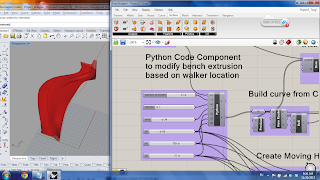For the second part of the project, I want to further develop the urban adapter to enhance its interactiveness.
I will conduct four tasks in these project:
1. Apply design pattern "reactor" to correspond to moving obstacle
2. Adopt new method to correspond to environment variable route and background
3. Using Python Script to correspond to walker behavior
4. Add new skin
1. the CA design pattern "Reactor" is modified to manipulate the form of the bench to automatically correspond to the obstacle
Create moving obstacles
2. For part 1 of the project, I extracted the XYZ value of control points to make change, here I directly use vectors to move control points
Only the upper part of the CP will be moved by splitting the list
3. Using Python script to build a welcoming bench that extend when people approach
Simple physical principle laid the foundation of the function, assuming bench are moving towards people at the same speed as the people object. I applied two conditions somehow to do the extrusion:
a. when people object is closer enough (distance <=100)
b. only extrude part of the bench ( within 40 along X axis)
4. Design new skin





























